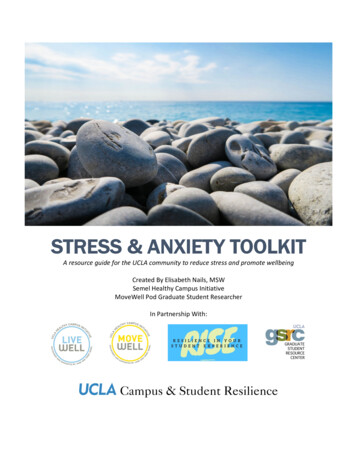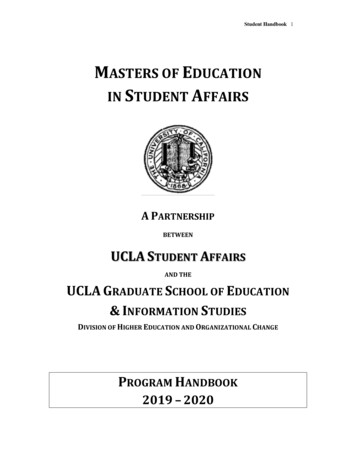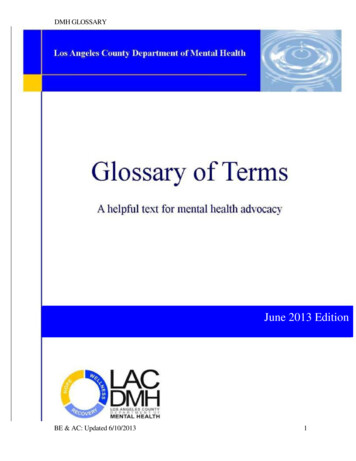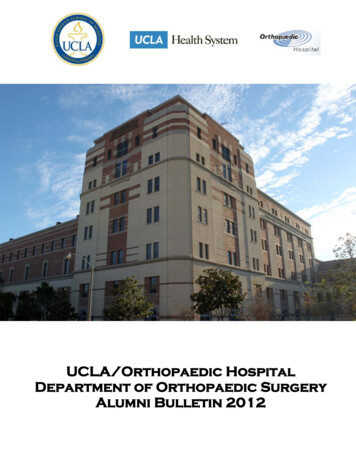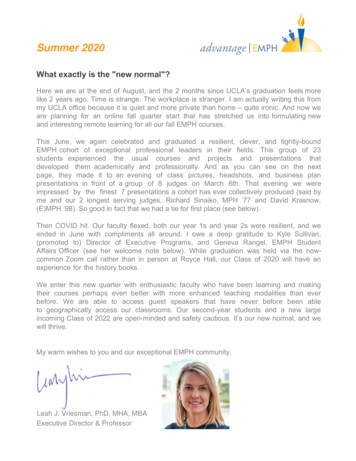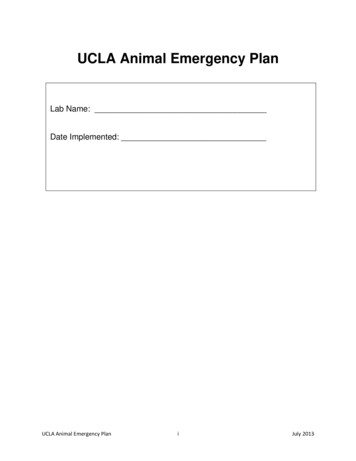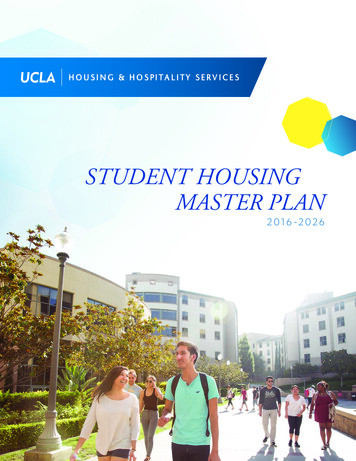
Transcription
STUDENT HOUSINGMASTER PLAN2 0 1 6 -2 0 2 6
TABLE OF CONTENTSEXECUTIVE SUMMARY. 1KEY PLANNING PRINCIPLES. 1HOUSING GOALS. . . 2OVERVIEW. 2THE CAMPUS PLANNING ENVIRONMENT. 3CHALLENGES FOR THE FUTURE. 4KEY PLANNING PRINCIPLES. 5HOUSING GOALS. . . 13IMPLICATIONS OF THE REVISED MASTER PLAN GOALS & RECOMMENDATIONS. . . 14SUPPORTING FACTORS FOR INCREASING INVENTORY OFUNIVERSITY - OWNED STUDENT HOUSING. . . 15IMPACT OF UPDATED STUDENT HOUSING MASTER PLAN RECOMMENDATIONS. 15RECOMMENDED PATH FORWARD. 16Revised: May 2017
EXECUTIVE SUMMARYThe UCLA Student Housing Master Plan — consistent with predecessor UCLA Student Housing Master Plans —outlines a set of long-term strategic aspirations for the housing program at UCLA. Together with key planningprinciples described in the document, the updated Master Plan is intended to directly link housing program goalsto institutional objectives in support of the campus academic mission.In light of increasing demand for University-owned housing, the Master Plan acknowledges the importance of university housing to support undergraduate students during their transition to UCLA. In addition, university housingprovides much needed academic, leadership, and personal growth experiences to support retention and to enrichthe quality of the undergraduate experience at UCLA. The Master Plan also endorses the importance of housingas a resource to support recruitment of graduate and professional students and to provide assistance during theirtransition to the University.UCLA Housing & Hospitality Services’ primary mission is to continue the transformation of UCLA from a commuterto a residential campus minimizing the need for vehicle trips to and from campus and ensuring affordable housingoptions for Bruin generations to come.Our secondary mission is to create environments that empower residents, guests, and team members to reach theirfullest potential. We do this by investing in healthy and innovative dining concepts, and building and renovatingour facilities to ensure that living in university accommodations is a pleasant, safe, and healthy experience. We alsoprovide exceptional fitness and recreational facilities in convenient locations, and offer a wide variety of study spacesto enhance the living and learning experience at UCLA.KEY PLANNING PRINCIPLESThere are seven key planning principles to guide the Master Plan:1.University housing is a vital resource to support the recruitment, transition, personal growth anddevelopment, academic achievement, retention, and graduation of undergraduate students.2.Affordability and living options must be considered in developing the student housing program.3.Limited land and resources require a high density living model in order to maximize the number4.of students housed, with a focus on a high quality living experience.Housing is a vital resource used to support the recruitment and retention of graduate andprofessional students.5.6.7.University housing helps create a supportive and cohesive student community by integrating thehousing program with other aspects of campus life.Allocation strategies must be refined to ensure that housing resources support both academic programobjectives and student recruitment and retention goals.Housing needs of postdoctoral scholars should be addressed after the campus has met the housingneeds of graduate and professional students.
HOUSING GOALSThe seven key planning principles led to the following four overarching goals with respect to the campushousing program:GOAL 1: University housing will be guaranteed to all entering first-year students for a period of four years.GOAL 2: University housing will be guaranteed to all new transfer students for a period of two years.GOAL 3: University housing will be guaranteed to new graduate and professional students for a periodof two years. University housing will be guaranteed to new graduate and professional student families with .dependent children for as long as the student is making normal progress to degree conferment for up toseven years.GOAL 4: University housing will be available to single postdoctoral scholars for a period of two years,as supply is available. University housing will be available to new postdoctoral scholars with dependentchildren for as long as the individual is participating in a postgraduate program for up to seven years,as supply is available.OVERVIEWIn 1986, UCLA drafted its first comprehensive Student Housing Master Plan, designed to provide direction to thecampus in addressing student housing needs in support of the institution’s academic mission. Subsequent revisionsof the Student Housing Master Plan were completed in 1990, 2000, 2007, 2010, and 2011.In 2016, an updated housing supply and demand analysis was conducted to assess changes in critical assumptionsconcerning campus enrollment projections, available student housing inventory, and occupancy expectations.The assumptions were as follows: Accommodate the proposed increase of undergraduate students. Align triple projections to meet current trend information and assist in understanding when final guarantees can be met.Update take-rate percentages to match evolved trends for housing for both graduate and under-graduate students.STUDENT HOUSING MASTER PLAN 2016-20262
THE CAMPUS PLANNING ENVIRONMENTSince the last Master Plan was approved in 2011, the campus planning environment has significantly changed. Whilethe planning principles and goals remain consistent with institutional objectives, housing enrollment and guaranteedstudent housing acceptance rates for first, third-year undergraduate students, first-year transfer students, and graduate students have increased significantly. All UC campuses are increasing enrollment of California residents overthe next four years. It is assumed that the current projected enrollment increases for the next four years would be1,500 Full Time Enrolled Students (FTE) or 2,100 headcount over the 28,500 base in fall 2015, which represents a 7percent increase. More specifically, the fall 2016 cohort would grow by 600 freshman and 150 transfer students, all ofthe increases coming from the California resident component of UCLA incoming students. These numbers continueto be evaluated by the Office of the President an UC campuses and could evolve in response to California residentenrollment targets.Normally, a 7 percent increase in student enrollment would not necessarily place a significant stress on the existingcampus facilities. However, when coupled with the 14 percent enrollment increase that occurred between fall 2010and fall 2014, which the campus is still in the process of absorbing, the cumulative impact presents serious challenges.For undergraduate students, the continued increase in housing demand highlights the success of the housing program, which has transformed UCLA from what was once predominantly a commuter campus to a residential campus.In a span of approximately 25 years, the campus has fostered the development of a unique residential environment,one in which the majority of undergraduates – and nearly all lower division students – live on or within walkingdistance of campus in a combination of University-owned housing and in private sector housing in Westwood.As the residential campus has evolved, the College of Letters and Science, Residential Life, and Housing & Hospitality Services have developed a collaborative partnership focused on a wide array of academic-oriented opportunitiesand academic support services for on-campus housing residents and, to some extent, for undergraduate studentswho live off campus. These programs and support services are offered within campus residential facilities, providinga unique benefit to students living on or adjacent to campus.UCLA has aspired to provide a four-year guarantee of housing for all first year undergraduate students and a twoyear guarantee for all new transfer students, while concurrently reducing the number of triple accommodations. Inpursuit of these objectives, an additional 1,500 bed spaces were constructed and added to the on-campus housinginventory, along with additional recreation and dining space. Originally, it was anticipated that the addition of these1,500 beds would enable UCLA to increase the guarantee for transfer students to a two-year standard, while freshmen would remain at the three-year guarantee. As a result of the student enrollment increase of FY 2011 throughFY 2014, however, these additional bed spaces were utilized to absorb this enrollment expansion, at the expenseof increasing the housing guarantees. Concurrently, the undergraduate off-campus apartment inventory was beingincreased. Landfair Vista was acquired in 2014, adding 178 beds. Landfair and Glenrock Apartments were bothredeveloped to add a net of 131 beds in fall 2014. Gayley Court, formerly Faculty Gayley, was converted in 2013 toundergraduate housing, netting 284 beds. The Margan Apartments will also be redeveloped starting in 2017, andreturn to inventory in 2019 with an additional 143 beds. Thus, the total incremental off-campus apartment inventoryincrease by 2019 will be 736 beds.
Housing has also concluded an aggressive systems renovation cycle for the on-campus housing inventory. Over thelast decade, buildings were taken offline during the academic year in order to complete necessary systems improvements: mechanical, electrical, plumbing, and infrastructure refurbishments to existing buildings. Decreasing theinventory while enrollment has been simultaneously growing, resulted in higher than desired triple occupancypercentages. This cycle is concluding with completion of the Delta Terrace renovation this academic year. Allon-campus inventory will be online for the 2016-2017 academic year. With systems renovations complete, theplanned renovations over the next two decades will be light in nature, targeting: carpet, paint, wall vinyl, andwhen possible incorporating energy efficient elements. These light renovations will typically be initiated during thesummer and will be completed prior to fall student move-in.Dining is an essential element in providing a quality residential experience. The housing program has not onlyfocused on adding additional seating to accommodate recent enrollment increases, but has also invested in infrastructure improvements to gain efficiencies in food production and increase quality. As part of the phased buildoutin 2013, an all-you-care-to-eat dining facility, Bruin Plate, in Carnesale Commons was added. Bruin Plate innovatedplatform dining, featuring locally-sourced produce and meats from nearby farms, sustainable seafood, unprocessedand preservative-free items, organic foods, cage-free eggs, nutrient-packed ingredients, and expanded vegetarianand vegan options, in a light-filled venue with a capacity of 710 seats.In Winter 2017, Housing introduced a new boutique, The Study at Hedrick. This new space innovates how studentscan eat and study together. The Study is an artisanal bakery with flexible study space that adds 350 seats. It will bethe first 24-hour eatery and study space of its kind in higher education.For graduate students, additional graduate housing must continue to be a campus priority. With the completionof Weyburn Terrace II in 2013 and the Hilgard Houses in 2010, which collectively provide 1,960 apartment-style bedsfor single graduate students, the campus is able to provide housing to approximately 24 percent of graduate andprofessional students. In addition, the campus is able to provide academic departments with a limited number ofbed spaces to allocate to graduate students, but does not have sufficient inventory to guarantee housing to all graduate students. The University’s inability to offer guaranteed housing to all newly recruited graduate students presentsa serious challenge to the campus when competing against other educational institutions.CHALLENGES FOR THE FUTUREDespite the notable success in planning for and meeting student housing needs, several challenges face thecampus housing program. Of greatest significance is that the current demand for housing significantly exceedsexisting supply. While UCLA is able to guarantee university housing for three years to every new freshman studentwho currently requests such housing, a large portion of the guarantees are being met by housing three students inrooms originally designed for two (referred to as “triples”). Between the mid-1970s and the late 1980s, the oncampus housing program operated at 100 percent occupancy. Since the early 1990s, occupancy with triple roomshas exceeded 125 percent. Even with the additional beds from new developments, redevelopments, conversion offaculty buildings, and renovations, Housing is meeting current guarantees by maintaining higher than desired tripleoccupancy percentages.STUDENT HOUSING MASTER PLAN 2016-20264
CHALLENGES FOR THE FUTURE(CONTINUED)Without additional beds, the projected enrollment increases for FY 2017 through FY 2020 will result in triple occupancy that will exceed 75 percent.This result is in stark comparison to the aspiration to provide a four-year guarantee for freshmen and a two-yearguarantee for transfers with triple occupancy in the range of 60-65 percent. Cuts in state funding and the resultingincreases in tuition have put a strain on financial resources for students and families. To lessen the impact, UCLAHousing continues to contain costs to keep university housing affordable and accessible.Finally, meeting the demands for graduate student housing remains a priority for the housing program. The Weyburn Terrace Phase II Graduate Student Housing Project added 500 apartment-style beds and reduced the currentshortfall of beds for single graduate students. It is clear that to resolve the graduate housing shortfall, the campuswill need to continue to supplement existing inventory with the purchase and development of additional apartmentbuildings.KEY PLANNING PRINCIPLESA fundamental tenet underlying the Master Plan is the aspiration to continue the significant progress made to datein transforming UCLA to a residential campus. Eight key planning principles dealing with the philosophy and intentof the UCLA housing program support the continuing transformation process as well as other institutional goals forstudent recruitment, retention, and academic progress. These principles are summarized below.1On-campus housing is a vital resource to support the recruitment, transition, personal growth anddevelopment, academic achievement, retention, and graduation of undergraduate students.UCLA’s excellent academic reputation continues to attract undergraduate students to the campus — in fact, thenumber of undergraduate applications far exceeds available admissions space each year. As competition hasincreased for students of the very highest caliber, the campus has begun to use more sophisticated recruitmentstrategies to help attract the most sought-after students. Top high school graduates, especially students fromunder-represented minority backgrounds and non-residents, typically receive offers of admission from multiplehighly-selective institutions. To be competitive, UCLA must be able to offer these students an array of campusservices, support, and resources designed to enhance the attractiveness of campus life at UCLA.Many institutions with which UCLA competes offer guaranteed housing for entering undergraduates for varyinglengths of time up to four years. Thus, the availability of on-campus housing at UCLA is vital to recruiting highlydesirable entering undergraduate students. For entering undergraduate students, on-campus housing helpsease the transition to university life by providing numerous benefits in addition to convenience and affordability.
On-campus housing facilities are within walking distance of classrooms, libraries, laboratories, recreation facilities,and other campus resources. In addition, within on-campus housing facilities, undergraduate students can takeadvantage of numerous types of academic programs, academic support services, personal growth and leadershipopportunities, community activities, and a wide range of employment opportunities. For example, programs suchas the Faculty-in-Residence program help break down the barriers associated with attending a large university andmake one-to-one interaction with faculty not only possible, but common. Additionally, the majority of the parents ofthese entering undergraduates want their children to live on campus because of UCLA’s reputation for providing safeaccommodations with a variety of programs and services that promote academic success, personal growth,and development opportunities.Unlike graduate and professional students who typically have some experience living on their own, most newundergraduate students come to the University with little or no independent living experience. They must learn tobe successful in a highly competitive academic environment, while adjusting to the challenges of living independently and making decisions that will impact their personal lives. Similarly, transfer students come to the University in themiddle of their educational program. These entering UCLA students must quickly adjust to the rigors of academiawhile adapting to their new residential environment.Additionally, dedicated space is available within residential facilities specifically for academic counseling, tutoringservices, and for regularly scheduled classes, seminars, and review sessions. This intellectually and socially rich livingenvironment nurtures academic achievement, retention, cognitive development, intellectual growth, and personalmaturation. Substantial amounts of research show that living on campus has a significant positive influence oncompletion of a bachelor’s degree, improvement of critical thinking skills and intellectual aptitude, and an increasein personal autonomy and independence.The Master Plan acknowledges the importance of housing as a primary resource to support undergraduate studentrecruitment and transition to the University. The provisions and guarantees incorporated into the Master Plan ensurethat institutional recruitment needs for undergraduates are addressed and that new undergraduate students andtransfer students are supported during their transition period to the University. Furthermore, the provisions contained in the Master Plan acknowledge the importance of supporting student retention and academic achievementfor all undergraduates who continue living on campus.2Affordability and living options must be considered in developing the student housing program.Of primary importance to the success of a student housing program is the relative affordability of University-ownedhousing compared to housing available in the private sector. Given the nature of the community surrounding UCLA,the types and amount of housing available proximate to campus, and the competition by non-students for housingin these desirable neighborhoods, it seems likely that student demand for affordable University-owned housing willcontinue to be strong in the foreseeable future.STUDENT HOUSING MASTER PLAN 2016-20266
PROGRESS lies not in enhancing what is,but in ADVANCING toward what will be. – kahlil gibranRendering of the Saxon Suites renovation, September 2015.
KEY PLANNING PRINCIPLES(CONTINUED)Current University housing options generally meet the criteria of being lower in cost than most comparable alternatives in the community. Similarly, UCLA’s on-campus housing program, which includes various dining options,is very competitive with similar room and board programs offered at other University of California campuses. TheWestwood housing market for rental properties is becoming unreachable for the vast majority of students. Studies1indicate that Westwood market rents could increase as much as 46 percent within the next eight years. Additionally,most of the inventory was constructed in the 1940s and 1950s. Limitations imposed by the Westwood Site SpecificPlan leave little financial incentive for owners of existing inventory to renovate or redevelop their parcels into moremodern facilities. Thus, it is probable that the Westwood housing inventory will be stagnant in terms of availabilityand quality but rapidly escalating in terms of cost.3Limited land and resources require a high density living model in order to maximize thenumber of students housed, with a focus on a high quality living experience.To meet the demands for proximate on-campus student housing, a model of high density living was implementedto maximize the number of students that could be accommodated. The UCLA Housing program has invested in fourkey areas to provide a high-quality, holistic living experience:1.Diverse & Healthy Dining OptionsWe are continuing to invest in the health of our students and guests with innovative dining concepts likeBruin Plate. This anchor facility focuses on fresh, wholesome, nutritionally-balanced food and beverageoptions, and best practices in sustainability in food service operations. Other award-winning and populardining concepts include FEAST at Rieber with a daily rotating pan-Asian menu and a Mediterranean-basedmenu featured at Covel Residential Restaurant.2.Convenient Fitness & Recreation FacilitiesAs part of our on campus residential community, the Bruin Fitness Center (BFit) opened in fall 2015 on theground floor of Carnesale Commons. Other facilities include Hedrick basketball courts, Spieker AquaticCenter, and Sunset Canyon Recreation Center, which features an Olympic size pool. The close proximityof fitness facilities to on-campus housing supports the university’s Healthy Campus Initiative.3.Clean & Well-maintained Living SpacesThe 20-year plan at H&HS is to keep every residential building on a continual renovation and refurbishmentschedule. By fall quarter 2016, all on- and off-campus inventory will be new or freshly renovated (within thelast seven to eight years) with a business model to ensure this work can continue for decades withoutrequiring dramatic year over year increases to housing fees.1Chiland, Elijah. “Rents Already Soaring Along L.A.’s Unopened Expo Line.” March 18, 2016. www.lacurbed.com
4.Flexible & Proximate Study SpacesOpening Winter 2017, The Study at Hedrick will be specially designed to meet the needs of today’sstudents and their demand for late night study space. The Study will feature natural light, around-the-clockcoffee and snacks, power outlets, reliable WiFi access, and a variety of comfortable options for private,communal, .and group studying. The Study complements other study spaces created within and adjacentto on-campus housing.4Housing is a resource that should be used to support the recruitment ofgraduate and professional students.In 2013, Phase II of the Weyburn Terrace Single Graduate Student Housing Project was completed. This projectprovided much needed on-campus guaranteed housing, increasing capacity to 1,960 single graduate bed spaces.The need for additional housing for graduate students is closely linked to UCLA’s position as a worldwide leaderin graduate education and research. UCLA seeks to recruit and retain the very best graduate students worldwide,and the quality, affordability, and proximity of housing to campus is integral to successfully recruiting new graduatestudents in all academic disciplines and professions. This is especially true for graduate students from outsidesouthern California, where the availability of housing is beneficial to their adjustment to the Los Angeles metropolitan area and lifestyle.While undergraduate students have been predominantly from California, many graduate and professional studentscome to UCLA from all over the world. Moreover, creation of dedicated on-campus graduate student housing provides an opportunity to create a graduate student community where traditional learning experiences can evolve andsupport new and creative levels of interdisciplinary focus and exchange. This potential is yet another means by whichUCLA can continue to distinguish itself in graduate education.Guaranteed housing for graduate students is also a critical recruitment mechanism. Students coming to campus fromoutside the Los Angeles basin value the availability of University-owned housing to help them become establishedin Los Angeles while adjusting to coursework at UCLA. Furthermore, housing on or proximate to campus benefitsgraduate and professional students by reducing commuting and transportation challenges and promotes accessto and use of resources available to students on campus. Finally, University-owned housing is more affordable thancomparable private sector housing, so graduate and professional student’s benefit from the associated cost savingsof living in University housing.In acknowledgement of the critical role housing plays in supporting graduate and professional student recruitment,the Master Plan contains provisions to address the ongoing housing needs of incoming graduate and professionalstudents and student families.STUDENT HOUSING MASTER PLAN 2016-202610
KEY PLANNING PRINCIPLES(CONTINUED)5On-campus housing helps create a supportive and cohesive student community.An important benefit of University-owned housing is the cohesive nature of the community formed by groupsof students living in close proximity to one another. Opportunities for interactions among students from differentpersonal backgrounds, interests, and academic pursuits contribute to the richness of the living environment.The student community formed within University-owned housing facilities contributes to the discovery and learningprocess. Student residents meet other students, form friendships, and participate in intellectual discussions thatadd to the quality of student life at UCLA.Students who live on campus in the residential community benefit greatly from the various academic, social, andlearning programs that are available. They also benefit from physical proximity to campus facilities and to servicesand programs such as libraries, health and counseling centers, recreation programs, student organization activities,and other campus-based academic and support services. These opportunities make for a richer educational experience and enhance the depth and breadth of student life. The Master Plan continues to support the developmentof on-campus housing which fosters a cohesive student community.6A successful residential campus integrates housing programs with other aspects of campus life.The concept of a residential campus must extend beyond the physical facilities of residence halls, apartment buildings, and meeting places. Like any master planned community, a residential campus is an integrated approach tothe total student experience. At UCLA, the residential community comprises of nearly all entering undergraduatesand approximately 80 percent of second-year undergraduates (100 percent of those who have lived in on-campushousing their first-year and apply for a second year), and about 40 percent of third-year undergraduates. In thefuture, increasing percentages of transfer and upper division students, as well as single graduate and professionalstudents, will join this community.The sheer size of the residential community dictates that consideration be given to the impact of the communityon campus programs, activities, and facilities that serve not only student residents, but the entire UCLA communityof students, faculty and staff. Of critical consideration is the impact of an increasing student community on recreation facilities and programs. The capacities of existing facilities — including both indoor facilities, such as the JohnWooden Center, and outdoor facilities, such as the Sunset Canyon Recreation Center — are likely to be exceededby the introduction of additional campus residents, and the impact will be noted by all users. Development of new
facilities, particularly facilities in close proximity to student housing, is essential to ensure that the entire campuscommunity will continue to have reasonable access to recreation facilities.The development of new academic support facilities (that promote student counseling, tutoring, study groups,student-faculty interactions, student services, etc.) will be essential to compliment those currently available. Theseexisting facilities are used with increasing frequency for both formal and informal undergraduate instruction.Additional space with the flexibility to accommodate academic programs will be required to support the growingstudent community on or near the northwest quadrant of campus. Additionally, in-room computing and additionalcomputer labs will still be required to provide for the increasing convergence of technology and academic instruction/research, even at the undergraduate level.O
The UCLA Student Housing Master Plan — consistent with predecessor UCLA Student Housing Master Plans — outlines a set of long-term strategic aspirations for the housing program at UCLA. Together with key planning principles described in the document, the updated Master Plan




